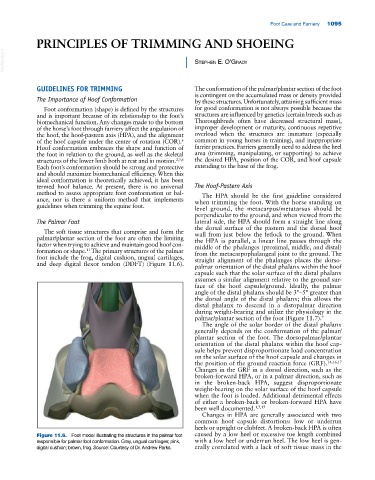Page 1129 - Adams and Stashak's Lameness in Horses, 7th Edition
P. 1129
Foot Care and Farriery 1095
PRINCIPLES OF TRIMMING AND SHOEING
VetBooks.ir Stephen e. O’Grady
GUIDELINES FOR TRIMMING The conformation of the palmar/plantar section of the foot
is contingent on the accumulated mass or density provided
The Importance of Hoof Conformation by these structures. Unfortunately, attaining sufficient mass
Foot conformation (shape) is defined by the structures for good conformation is not always possible because the
and is important because of its relationship to the foot’s structures are influenced by genetics (certain breeds such as
biomechanical function. Any changes made to the bottom Thoroughbreds often have decreased structural mass),
of the horse’s foot through farriery affect the angulation of improper development or maturity, continuous repetitive
the hoof, the hoof‐pastern axis (HPA), and the alignment overload when the structures are immature (especially
of the hoof capsule under the center of rotation (COR). common in young horses in training), and inappropriate
6
Hoof conformation embraces the shape and function of farrier practices. Farriers generally need to address the heel
the foot in relation to the ground, as well as the skeletal area (trimming, manipulating, or supporting) to achieve
structures of the lower limb both at rest and in motion. 2,3,6 the desired HPA, position of the COR, and hoof capsule
Each foot’s conformation should be strong and protective extending to the base of the frog.
and should maximize biomechanical efficiency. When this
ideal conformation is theoretically achieved, it has been
termed hoof balance. At present, there is no universal The Hoof‐Pastern Axis
method to assess appropriate foot conformation or bal The HPA should be the first guideline considered
ance, nor is there a uniform method that implements when trimming the foot. With the horse standing on
guidelines when trimming the equine foot. level ground, the metacarpus/metatarsus should be
perpendicular to the ground, and when viewed from the
The Palmar Foot lateral side, the HPA should form a straight line along
The soft tissue structures that comprise and form the the dorsal surface of the pastern and the dorsal hoof
wall from just below the fetlock to the ground. When
palmar/plantar section of the foot are often the limiting the HPA is parallel, a linear line passes through the
factor when trying to achieve and maintain good hoof con middle of the phalanges (proximal, middle, and distal)
11
formation or shape. The primary structures of the palmar from the metacarpophalangeal joint to the ground. The
foot include the frog, digital cushion, ungual cartilages, straight alignment of the phalanges places the dorso
and deep digital flexor tendon (DDFT) (Figure 11.6). palmar orientation of the distal phalanx within the hoof
capsule such that the solar surface of the distal phalanx
assumes a similar alignment relative to the ground sur
face of the hoof capsule/ground. Ideally, the palmar
angle of the distal phalanx should be 3°–5° greater than
the dorsal angle of the distal phalanx; this allows the
distal phalanx to descend in a distopalmar direction
during weight‐bearing and utilize the physiology in the
palmar/plantar section of the foot (Figure 11.7). 9
The angle of the solar border of the distal phalanx
generally depends on the conformation of the palmar/
plantar section of the foot. The dorsopalmar/plantar
orientation of the distal phalanx within the hoof cap
sule helps prevent disproportionate load concentration
on the solar surface of the hoof capsule and changes in
the position of the ground reaction force (GRF). 14,16,17
Changes in the GRF in a dorsal direction, such as the
broken‐forward HPA, or in a palmar direction, such as
in the broken‐back HPA, suggest disproportionate
weight‐bearing on the solar surface of the hoof capsule
when the foot is loaded. Additional detrimental effects
of either a broken‐back or broken‐forward HPA have
been well documented. 1,7,17
Changes in HPA are generally associated with two
common hoof capsule distortions: low or underrun
heels or upright or clubfeet. A broken‐back HPA is often
Figure 11.6. Foot model illustrating the structures in the palmar foot caused by a low heel or excessive toe length combined
responsible for palmar foot conformation. Gray, ungual cartilages; pink, with a low heel or underrun heel. The low heel is gen
digital cushion; brown, frog. Source: Courtesy of Dr. Andrew Parks. erally correlated with a lack of soft tissue mass in the

